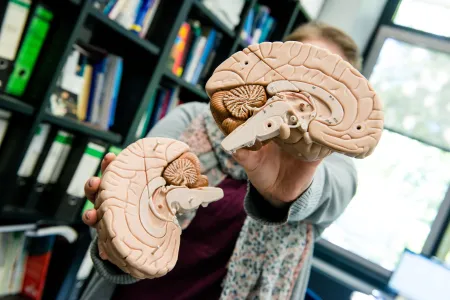
Neuroscience
How genes, brain characteristics and intelligence are connected
Genes influence different structures and the function of the brain. These in turn explain differences in behaviour. Analysing all three aspects at once is a challenge – but has now been achieved.
Intelligence is partly heritable. There are studies that show that certain genetic variations are linked to better performance in intelligence tests. Other studies show that a variety of brain characteristics, such as network efficiency, are related to intelligence. For the first time, researchers have now studied all three parameters – genes, different brain characteristics and behaviour – simultaneously. Using gene analyses, magnetic resonance imaging and intelligence tests, the team demonstrated which brain characteristics form the link between genes and behaviour.
The results are described by a team around Dorothea Metzen from the Department of Biopsychology at Ruhr University Bochum, Germany, and Dr. Erhan Genç, formerly at Ruhr University, now at the Leibniz Research Centre for Working Environment and Human Factors in Dortmund (IfADo), in the journal “Human Brain Mapping”, published online on 4 April 2023.

In addition to the IfADo and various institutions of Ruhr University, the Humboldt-Universität Berlin, the Central Institute of Mental Health in Mannheim, the Medical School Hamburg and the University of Luxembourg were involved. At Ruhr University, the biopsychology, human genetics and genetic psychology teams cooperated.
Genes, brain, behaviour – a unique data set
The team included 557 subjects aged between 18 and 75 years in the study. Using saliva samples, they analysed which individuals possessed how many gene variations associated with high intelligence. “There are thousands of genes that contribute to intelligence,” explains Dorothea Metzen. “We calculated a summary score for each person that reflects the genetic predisposition for high intelligence.”
In addition, all subjects took part in brain scans, which the researchers used to determine not only the thickness and surface area of the cerebral cortex, but also how efficiently the structural and functional networks in the brain are organized. All participants also completed an intelligence test. “The broadness and detailed recording of various data in this study is, as far as I am aware, unprecedented,” emphasises Erhan Genç. “For the first time, we looked at the triad of genes, different brain characteristics and behavioural traits as a whole.”
Specifically, the group analysed which differences in genetic variations are related to differences in brain characteristics and differences in behaviour.
Interplay of genes, brain characteristics and intelligence in a few brain regions
When the team only looked at the connection between genetic variations and brain characteristics – that is, disregarding intelligence test results – they found numerous associations in many regions distributed across the entire brain. Significantly fewer associations were apparent when the researchers investigated which brain characteristics were associated with intelligence test performance. When they considered all three parameters at once – genes, brain characteristics and intelligence test performance – an association was only found in few brain areas in the frontal, parietal and visual cortex. This means that there are only specific areas in the brain where gene variations influence brain characteristics, and these characteristics simultaneously affect intelligence. The decisive brain characteristics were the size of the brain surface and the efficiency of structural connectivity. The researchers found very few such connections between genes, brain and behaviour when they examined the thickness of the cerebral cortex and the efficiency of functional connectivity.
Method also transferable to other areas
With their study, the researchers hope to have proposed a method that can also be transferred to other areas. This is because it allows the interplay of genes, brain and behaviour to be studied not only for intelligence, but also for other traits. “It would also be interesting if such methods were used in the future with larger cohorts of thousands or tens of thousands of test subjects,” says Erhan Genç, because that would improve the quality of the results. “Studying the impact of age would also be an interesting future research project,” adds Genç.
